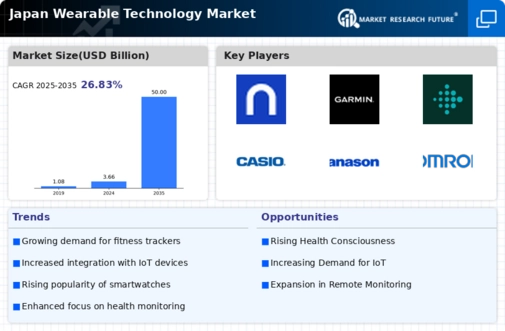The Japan Wearable Technology Market has seen significant growth fueled by advancements in technology and the increasing consumer demand for health and wellness monitoring devices. As more consumers leverage these technologies for fitness, lifestyle management, and personal health monitoring, the competitive landscape continues to evolve. The market is characterized by a variety of participants ranging from established tech giants to innovative startups, all striving to capture market share by offering distinct features, superior functionalities, and enhanced user experiences.
Companies are not only competing on the basis of product quality but also focusing on integrating artificial intelligence and data analytics, making wearables smarter and more efficient. As a result, the competitive insights reflect a dynamic environment where innovation and user-centric design play pivotal roles in determining market success.
NEC has positioned itself as a prominent player in the Japan Wearable Technology Market, emphasizing a strategy that leverages its extensive expertise in information and communication technology. NEC focuses on developing innovative wearables targeted at both individual consumers and enterprises, offering solutions that enhance productivity and operational efficiency. The company's strengths lie in its robust research and development capabilities, extensive experience in security and data management, as well as its strong partnerships within the technology ecosystem in Japan.
By continually investing in cutting-edge technologies such as biometrics and IoT, NEC is able to deliver unique features in its wearable devices that cater well to the specific needs of its domestic market, further solidifying its presence and competitive edge.
Samsung Electronics has cultivated a significant presence in the Japan Wearable Technology Market through a diverse range of wearable devices that cater to various consumer needs. The company's key products, including smartwatches, fitness trackers, and earbuds, showcase its commitment to combining stylish design with advanced technological functionality. Samsung's strengths lie in its strong brand recognition, extensive distribution channels, and a customer-centric approach that prioritizes user experience. The company continues to enhance its market position through strategic partnerships and collaborations within the local tech landscape, which aids in the refinement and promotion of its products.
Additionally, Samsung Electronics actively engages in mergers and acquisitions to broaden its technological capabilities and market reach, allowing it to stay competitive within the rapidly evolving landscape of wearable technology in Japan. This ensures that Samsung remains at the forefront of innovation, delivering products that resonate with Japanese consumers' preferences and lifestyles.




















